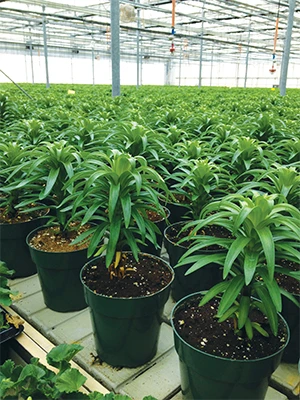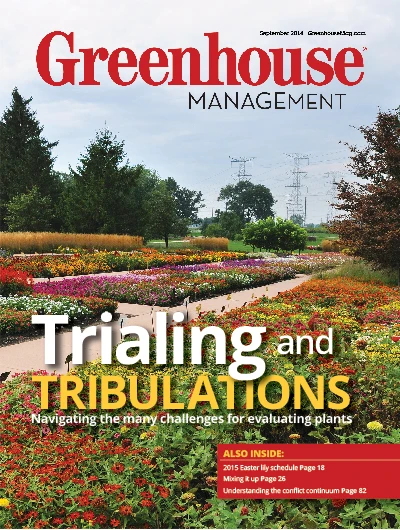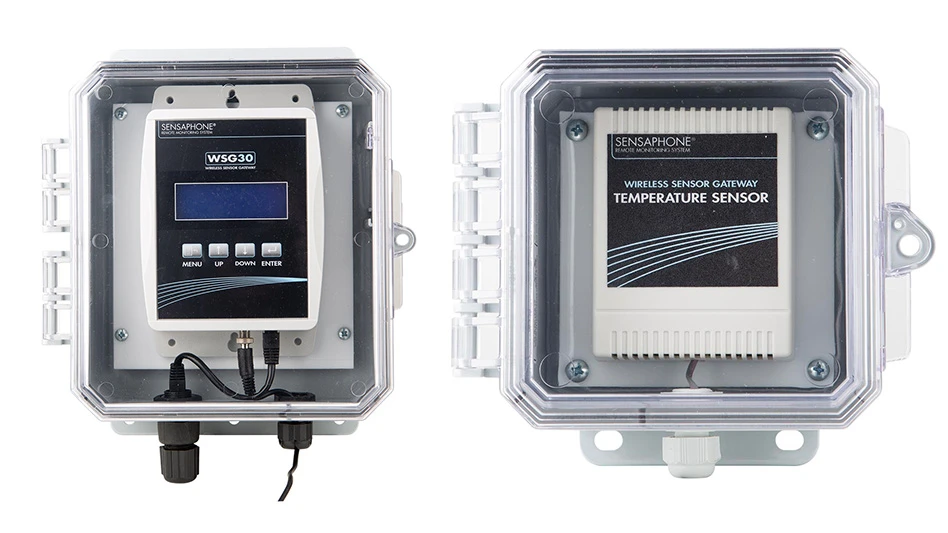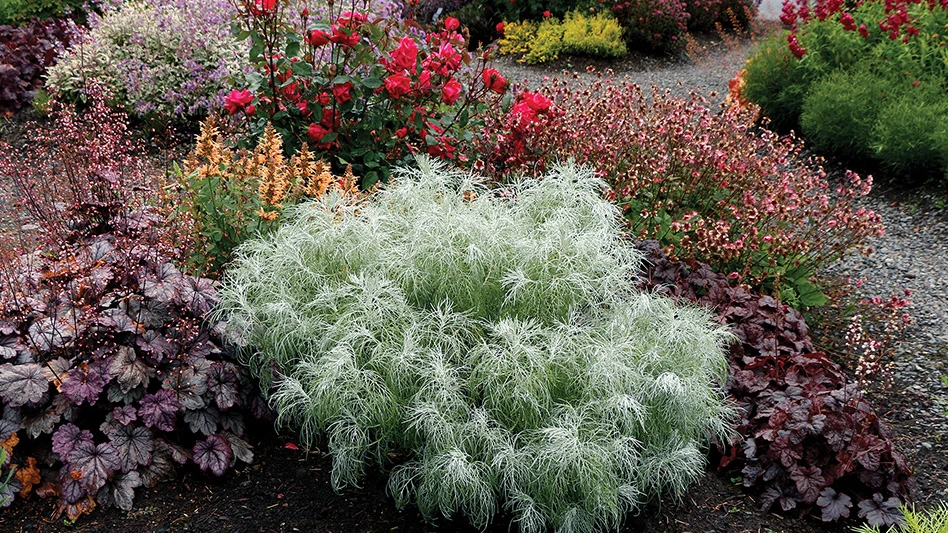
 When it comes to greenhouse forcing, middle dates are best and Easter 2015 is such a date. Easter Sunday always falls between March 22 and April 25, and next year’s date is April 5. This will enable growers to complete all steps in the 23-week forcing program without having to cut corners, as is sometimes the case with early Easter schedules. Mid-date schedules are also advantageous in that there is not a lot of extra time that requires growers to hold the mature crop in the cooler or to use other stalling tactics to slow growth, as is common with late Easter schedules, like last year when Easter came on April 20. But perhaps the biggest advantage for growers in the northern tier is that shipping lilies at the end of March opens up production space for those all-important spring crops.
When it comes to greenhouse forcing, middle dates are best and Easter 2015 is such a date. Easter Sunday always falls between March 22 and April 25, and next year’s date is April 5. This will enable growers to complete all steps in the 23-week forcing program without having to cut corners, as is sometimes the case with early Easter schedules. Mid-date schedules are also advantageous in that there is not a lot of extra time that requires growers to hold the mature crop in the cooler or to use other stalling tactics to slow growth, as is common with late Easter schedules, like last year when Easter came on April 20. But perhaps the biggest advantage for growers in the northern tier is that shipping lilies at the end of March opens up production space for those all-important spring crops.
This isn’t to say that this year’s mid-date Easter ensures an “easy” crop. As any experienced grower knows, each Easter crop presents a new challenge, not just because of the changing schedule but also because of the unpredictable year-to-year variability in bulb quality, bulb maturity, and weather.
Here’s what you need to know about this year’s schedule and steps.
Bulb cooling.
Start programming case-cooling bulbs at temperatures between 40°F-45°F for six weeks beginning Oct. 26 (23 weeks before Easter). If bulbs arrive later than Oct. 26 and you are not able to complete the full six weeks of bulb cooling by Dec. 7 (17 weeks before Easter), start the greenhouse forcing anyway and just substitute one week of insurance lighting for each week of cooling still needed. Insurance lighting refers to night break lighting used to produce a long day photoperiod. Apply insurance lighting immediately following shoot emergence to produce the same effect as bulb cooling.
For pot-cooled lilies (including CTF and natural-cooled) start bulb programming by Oct. 26 and hold at 60°F -62°F for three weeks in order to stimulate root development. Then transfer the potted bulbs to the cooler on Nov. 16 (20 weeks before Easter) to start the six weeks of cooling at 40°F -45°F. Start greenhouse forcing by Dec. 28 (14 weeks before Easter). Again, if bulbs arrive late and you don’t have time for the full three weeks of rooting prior to bulb cooling, just give them as much time as the schedule permits prior to Nov. 16 and start the six-week cooling period on schedule.
 With naturally cooled bulbs, temperatures can vary widely from the preferred range. Temperatures that are too low or too high are less effective. As a rule do not allow bulbs to freeze, and do not include hours accumulated over 50°F as part of the total hours. Subtract hours accumulated over 70°F. Monitor the temperature in the pot each day and once the targeted six-week vernalization period is complete, reassess your schedule.
With naturally cooled bulbs, temperatures can vary widely from the preferred range. Temperatures that are too low or too high are less effective. As a rule do not allow bulbs to freeze, and do not include hours accumulated over 50°F as part of the total hours. Subtract hours accumulated over 70°F. Monitor the temperature in the pot each day and once the targeted six-week vernalization period is complete, reassess your schedule.
Regardless of the bulb cooling method you plan to use, inspect bulbs as soon as they arrive, discard any diseased or damaged bulbs, and begin bulb programming (cooling, or rooting and cooling) immediately. Maintain temperatures between 40°F-45°F for the entire six-week cooling period.
Greenhouse forcing and bud initiation.
With both pot-cooled and case-cooled lilies, greenhouse forcing starts at the end of the bulb-cooling period. Typically this is 17 weeks before Easter for case-cooled bulbs and 14 weeks before Easter for pot-cooled bulbs. The difference in the two schedules reflects the stage of shoot development. With pot-cooled bulbs the shoots are either at the soil surface or already emerged as soon as forcing begins (week 14). In contrast, case-cooled bulbs will take up to three weeks to emerge. So either way, the shoots on both crops should be emerging by about week 14 (Dec. 28).
Bud initiation begins soon after lilies emerge, and should be completed no later than mid-January this year, when shoots are three to five inches tall. The development of stem roots coincides with flower bud initiation. During bud initiation, a constant 63°F temperature is ideal but day and night temperatures in the range of 60°F-65°F are fine. It is important that temperatures do not exceed 65°F until bud initiation is complete. If you determine that lily development is behind schedule, don’t try to catch up by forcing at high temperatures during this phase. Wait until bud set is complete before attempting to speed up plant development with higher temperatures.
Tracking lily development.
Use the leaf counting technique to track lily development. You should be able to start an initial assessment as soon as bud initiation is complete, by week 11 or week 10. Run lower average daily temperatures (55°F -60°F) if lilies are ahead of schedule or higher temperatures (70°F) if behind schedule. Typical leaf unfolding rates vary from approximately one leaf per day at 53°F to one-and-one-half leaves per day at 63°F, two leaves per day at 72°F, and two-and-one-half leaves per day at 82°F. Forcing temperatures between 55°F and 70°F produce the highest quality lilies and are most fuel-efficient.
Taking an initial leaf count as early as possible will allow you get back on track with modest temperature adjustments. Don’t wait until the schedule is at or near visible bud to assess crop development, or you may find yourself having to manage crop development using temperature extremes. Your control options will be much more limited if you wait until the final six weeks of greenhouse forcing to discover your lilies are far ahead or far behind schedule.
Once greenhouse forcing starts, lilies should reach the visible bud stage at about Feb. 22, (six weeks before Easter). Lilies at this stage will typically reach the open bud stage in 35 days at 65°F, in time for shipping one week before Easter.
Visible bud to finish.
Once at visible bud, monitor crop development by measuring bud length. Adjust temperature as needed to stay on schedule. A ‘bud stick’ is a useful tool to gauge the rate of lily bud development and the temperature regime needed to finish at a specific date. If you don’t have a bud stick, refer to Table 1 (below) to estimate the rate of bud development. I recommend you assess bud development early and adjust temperatures accordingly.
Uneven temperatures produce uneven crops. Use horizontal airflow to equalize greenhouse air temperatures. If you need to use temperatures above 80°F to push lilies at the end, take care to maintain adequate soil moisture and humidity levels, or lily development may stall and buds may abort.

Holding lilies in cold storage.
Lilies can be stored for up to 14 days in the dark at 35°F-45°FF when buds turn white, but before they open. A preventive spray treatment for Botrytis control is recommended prior to moving lilies to cold storage. An application of Fascination or Fresco prior to cold storage will prevent late-season leaf yellowing and post-harvest flower senescence. Spray 100/100 ppm to thoroughly cover all foliage and buds when buds are 3- to 3½-inches long but not more than 14 days before shipping or cold storage. Easter lilies need to be watered thoroughly before starting cold storage. After removing from the cooler, place lilies in a shady location to avoid excessive wilting.
Height control.
 Conventional PGR practices recommend a single application of a growth retardant plant growth regulator (PGR) when shoots are 3- to 5-inches tall, with a dose high enough to provide control for 3 to 5 weeks. The products A-Rest, Concise, Topflor or Sumagic are all effective growth retardants on Easter lilies. Note: paclobutrazol products such as Bonzi are not effective on Easter lilies. Use DIF to control lily height during flower initiation. Avoid using high dose PGR applications until after flower bud initiation is complete (around Jan.11 or soon after this season). Alternatively, equal day/night temperatures or cool morning temperatures will produce a DIF effect and keep lilies short.
Conventional PGR practices recommend a single application of a growth retardant plant growth regulator (PGR) when shoots are 3- to 5-inches tall, with a dose high enough to provide control for 3 to 5 weeks. The products A-Rest, Concise, Topflor or Sumagic are all effective growth retardants on Easter lilies. Note: paclobutrazol products such as Bonzi are not effective on Easter lilies. Use DIF to control lily height during flower initiation. Avoid using high dose PGR applications until after flower bud initiation is complete (around Jan.11 or soon after this season). Alternatively, equal day/night temperatures or cool morning temperatures will produce a DIF effect and keep lilies short.
Even if you choose to use more conventional PGR practices, split applications are preferred. Split applications produce the most desirable plants. With split applications, use half the normal dose at the first application and then a one-quarter to one-half dosage in subsequent applications (depending on the number of applications you plan to use and the amount of control needed). Lilies exposed to high concentrations of growth retardants have a greater tendency to develop lower leaf yellowing in the later stages of production. Some growers have been applying growth retardants at low concentrations just as the shoot emerges and then following with a second application when bud initiation is complete. I prefer to allow bud initiation to be completed before altering natural hormone levels in the plant. Plus, by maintaining a constant 63°F day and night during bud initiation you are imposing a zero DIF regime that will limit stretching. If you still wish to apply PGRs at this time, I recommend the lowest effective dose (1/8th to 1/4th the normal dose). Just apply enough to hold the plant for 7 to 0 days rather than the typical 3 to 5 weeks.
You can use weekly applications at very low dosages to either slow stem stretch with a growth retardant like Sumagic or increase stem stretch with products containing gibberellins such as in Fascination or Fresco. Fascination and Fresco also can be used to prevent leaf yellowing in closely spaced plants.
With sequential, low-dose treatments, PGRs can be applied anytime during the greenhouse forcing cycle.
Nutrition.
Proper nutrition is important in early crop development. Limiting nitrogen early in development reduces leaf size, and small leaves limit the potential for subsequent growth. To get plants off to a good start, provide a single application of 400-600 ppm nitrogen at first irrigation, when lilies begin to emerge after programming. This will help to stimulate early leaf development. Phosphorus is also important in early lily development by supporting strong root development. Growers sometimes withhold phosphorus out of fear of leaf scorch from fluoride toxicity (fluoride is a found in phosphorus based fertilizers and some soil amendments). Use a complete fertilizer formulation, such as a 20-10-20, for the initial feed.
After the initial feeding use a 15-0-15 formulation, but if phosphorus was not added to the medium use the 20-10-20 formulation on an alternating basis with the 15-0-15. Fertilizer rates should range from 200 to 400 ppm. Do not allow medium EC to exceed 3 to 3.5 mS/cm based on a Saturated Media Extract. Periodic nutrient testing is advisable during the crop. Testing the nutrient status of young fully expanded leaves will provide the most accurate picture of lily nutritional health. Leaf tissue nutrient content should fall in the following ranges, 2.4 to 4 percent nitrogen, 0.1 to 0.7 percent phosphorus, 2 to 5 percent potassium, 0.2 to 4 percent calcium, 0.3 to 2 percent magnesium, 100 to 250 ppm iron, 50 to 250 ppm manganese, 30 to 70 ppm zinc, 5 to 25 ppm copper, and 20 to 50 ppm boron.
For success in 2015, keep a close eye on development from the start. Follow the 2015 schedule to track development and the cultural recommendations to maintain proper plant health and vigor during greenhouse forcing. As always if you do spot a problem, react and make adjustments early to avoid more difficult adjustments later.

Richard J. McAvoy is professor and extension specialist—greenhouse crops at the University of Connecticut.

Explore the September 2014 Issue
Check out more from this issue and find your next story to read.
Latest from Greenhouse Management
- Meet the All-America Selections AAS winners for 2025
- AmericanHort accepting applications for HortScholars program at Cultivate'25
- BioWorks hires Curt Granger as business development manager for specialty agriculture
- 2025 Farwest Show booth applications now open
- Bug budget boom
- Don’t overlook the label
- Hurricane Helene: Florida agricultural production losses top $40M, UF economists estimate
- No shelter!





